

Scientists build a machine to generate quantum superposition of possible futures. In the 2018 movie Avengers: Infinity War, a scene featured Dr.

Confirmed: New phase of matter is solid and liquid at same time. Solid, liquid, gas … and something else?
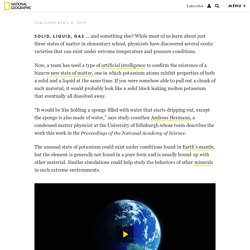
While most of us learn about just three states of matter in elementary school, physicists have discovered several exotic varieties that can exist under extreme temperature and pressure conditions. Researchers make coldest quantum gas of molecules. JILA researchers have made a long-lived, record-cold gas of molecules that follow the wave patterns of quantum mechanics instead of the strictly particle nature of ordinary classical physics.

The creation of this gas boosts the odds for advances in fields such as designer chemistry and quantum computing. As featured on the cover of the Feb. 22 issue of Science, the team produced a gas of potassium-rubidium (KRb) molecules at temperatures as low as 50 nanokelvin (nK). That's 50 billionths of a Kelvin, or just a smidge above absolute zero, the lowest theoretically possible temperature. Machine learning reveals hidden turtle pattern in quantum fireworks. Two years ago, physicists at the University of Chicago were greeted with fireworks—atoms shooting out in jets—when they discovered a new form of quantum behavior.
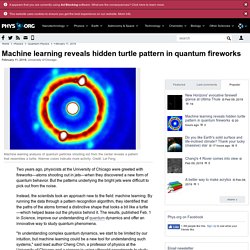
But the patterns underlying the bright jets were difficult to pick out from the noise. Instead, the scientists took an approach new to the field: machine learning. By running the data through a pattern recognition algorithm, they identified that the paths of the atoms formed a distinctive shape that looks a bit like a turtle—which helped tease out the physics behind it. The results, published Feb. 1 in Science, improve our understanding of quantum dynamics and offer an innovative way to study quantum phenomena. In the original study, Chin's lab cooled particles down to nearly absolute zero until they all condensed into the same quantum state, called a Bose-Einstein condensate. Molecules chilled close to absolute zero just smashed a new physics record. A two-step cooling process using lasers has allowed physicists to push molecules of calcium monofluoride down to a record low temperature, busting a barrier that until now has been impassable.
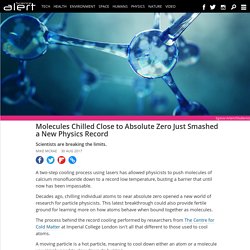
Decades ago, chilling individual atoms to near absolute zero opened a new world of research for particle physicists. This latest breakthrough could also provide fertile ground for learning more on how atoms behave when bound together as molecules. Physicists just found one of the forces holding the world together can also push it apart. A type of force that makes molecules briefly stick to one another has been shown to have a more repulsive side, even when they aren't being squeezed together.
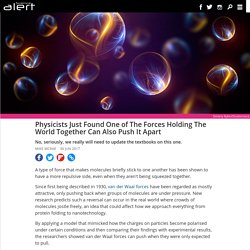
Since first being described in 1930, van der Waal forces have been regarded as mostly attractive, only pushing back when groups of molecules are under pressure. New research predicts such a reversal can occur in the real world where crowds of molecules jostle freely, an idea that could affect how we approach everything from protein folding to nanotechnology. By applying a model that mimicked how the charges on particles become polarised under certain conditions and then comparing their findings with experimental results, the researchers showed van der Waal forces can push when they were only expected to pull.
To get a better idea of exactly what this means, it helps to understand that van der Waal forces are like the little brother to the bonds that connect atoms to one another. That's referred to as an electron charge density. Physicists Are 'Breeding' Schrödinger's Cat, and it Could Reveal the Limits of the Quantum World. This strange light particle behaviour challenges our understanding of quantum theory. Scientists investigating how light particles (or photons) experience entanglement on the quantum scale have discovered something entirely unexpected, and it challenges long-held assumptions about the initial moments of what Einstein referred to as "spooky action at a distance".
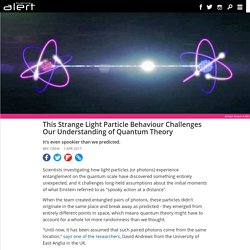
When the team created entangled pairs of photons, these particles didn't originate in the same place and break away as predicted - they emerged from entirely different points in space, which means quantum theory might have to account for a whole lot more randomness than we thought. The Large Hadron Collider just identified 5 new subatomic particles. A Unique Find The Large Hadron Collider (LHC), the latest addition to CERN’s accelerator complex, is the most powerful particle accelerator ever built.
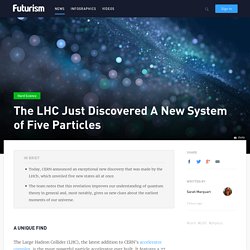
It's Official. Cooling to Absolute Zero Is Mathematically Impossible. In Brief Scientists have proven the third law of thermodynamics.
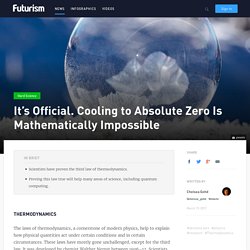
Proving this law true will help many areas of science, including quantum computing. Thermodynamics The laws of thermodynamics, a cornerstone of modern physics, help to explain how physical quantities act under certain conditions and in certain circumstances. These laws have mostly gone unchallenged, except for the third law. Power Rangers' Plan to Time Travel in Large Hadron Collider Isn't Sci-Fi. There’s something familiar about the time machine in the latest Justice League/Power Rangers crossover comic: In the latest issue of the series, the superheroes gather at the mouth of what seems to be the Large Hadron Collider, Geneva’s massive particle accelerator, discussing how to use it to jump across universes.
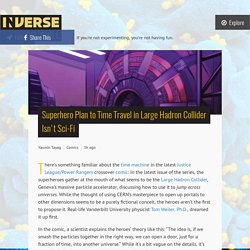
While the thought of using CERN’s masterpiece to open up portals to other dimensions seems to be a purely fictional conceit, the heroes aren’t the first to propose it. Real-life Vanderbilt University physicist Tom Weiler, Ph.D., dreamed it up first. Scientists Store Data on Single Atoms. Golden ratio discovered in quantum world: Hidden symmetry observed for the first time in solid state matter. Researchers from the Helmholtz-Zentrum Berlin für Materialien und Energie (HZB), in cooperation with colleagues from Oxford and Bristol Universities, as well as the Rutherford Appleton Laboratory, UK, have for the first time observed a nanoscale symmetry hidden in solid state matter.
Scientists Have Found the 'Holy Grail' of Physics, Metallic Hydrogen. Two Harvard scientists have succeeded in creating an entirely new substance long believed to be the “holy grail” of physics — metallic hydrogen, a material of unparalleled power that could one day propel humans into deep space. The research was published in January in the journal Science. Scientists created the metallic hydrogen by pressurizing a hydrogen sample to more pounds per square inch than exists at the center of the Earth.
This broke the molecule down from its solid state and allowed the particles to dissociate into atomic hydrogen. The best rocket fuel we currently have is liquid hydrogen and liquid oxygen, burned for propellant. Physicists have found a metal that conducts electricity but not heat. Researchers have identified a metal that conducts electricity without conducting heat - an incredibly useful property that defies our current understanding of how conductors work. The metal contradicts something called the Wiedemann-Franz Law, which basically states that good conductors of electricity will also be proportionally good conductors of heat, which is why things like motors and appliances get so hot when you use them regularly.
"This was a totally unexpected finding," said lead researcher Junqiao Wu, from Berkeley Lab’s Materials Sciences Division. Scientists have measured the smallest fragment of time ever. Physicists might have found a way to break the Second Law of Thermodynamics. The laws of thermodynamics are some of the most important principles in modern physics, because they define how three fundamental physical quantities - temperature, energy, and entropy - behave under various circumstances. But now physicists say they’ve found a loophole in one of these laws, and it could create scenarios in which entropy - or disorder - actually decreases with time. Thanks to modern physics, almost everything in the Universe can be explained according to two theories: general relativity for the big stuff like stars, galaxies, and the Universe itself; and quantum mechanics, for behaviours on the atomic scale.
Within those two branches, we have the four laws of thermodynamics, which describe how heat (or thermal energy) is converted to and from different types of energy, and the effect that this can have on various forms of matter. Basically, if you want to know how energy moves within a system - from an atom to a black hole - these are the laws you’ll need. Boosting the force of empty space. Helium atoms put in same quantum state, start appearing in same place. Quantum mechanics has so many counterintuitive features that it seems possible to learn a new one every month. Today's lesson involves particles that are set into the same quantum state and effectively become indistinguishable. Once they are indistinguishable, they start behaving that way, showing up in the same place even when we'd expect to see them distributed at random. Physicists Say Consciousness Might Be a State of Matter — NOVA Next. It’s not enough to have a brain.
Physicists Zap a Semiconductor with a Laser, Accidentally Produce a New Quasiparticle. Recently, a team of physicists was bombarding a film of gallium arsenide with a mode-locked titanium-sapphire laser. They focused the beam into an incredibly fine dot, just 100 nm, pulsed the beam for 320 femtosectonds (320 quadrillionths of a second), and waited to see what happened. You know, just another day in the lab. Well, waiting might be an overstatement. What the team was looking for were quasiparticles known as excitons, which they found in spades. Icists show 'quantum freezing phenomenon' is universal. (Phys.org)—Physicists who work on quantum technologies are always looking for ways to manage decoherence, which occurs when a quantum system unavoidably interacts with the surrounding environment.
Digging into the “Giant Resonance”, scientists find hints of new quantum physics. A cooperation between theoretical and experimental physicists has uncovered previously unknown quantum states inside atoms. Descubren la forma de «mirar» dentro de un agujero negro. Si rompemos un documento en mil pedazos, siempre habrá una forma de recomponerlo y acceder, por lo tanto, a la información que contenía. Single-particle ‘spooky action at a distance’ finally demonstrated. For the first time, researchers have demonstrated what Albert Einstein called "spooky action at a distance" using a single particle. Superfluid helium can leak through glass and climb out of its container. ‘Cloaking’ device uses ordinary lenses to hide objects across range of angles : NewsCenter.
Doctoral student Joseph Choi is pictured with a a multidirectional `perfect paraxial’ cloak using 4 lenses. Inspired perhaps by Harry Potter’s invisibility cloak, scientists have recently developed several ways—some simple and some involving new technologies—to hide objects from view. The latest effort, developed at the University of Rochester, not only overcomes some of the limitations of previous devices, but it uses inexpensive, readily available materials in a novel configuration. “There’ve been many high tech approaches to cloaking and the basic idea behind these is to take light and have it pass around something as if it isn’t there, often using high-tech or exotic materials,” said John Howell, a professor of physics at the University of Rochester.
The Mathematics of Quantum Atom Theory. Quantum Physics authors/titles recent submissions (40 skipped) 1408.1990.pdf. 1408.1769.pdf. [1407.3194] The quantum pigeonhole principle and the nature of quantum correlations. Sub-Structure of the Electron and Mass Relation of Leptons and Nucleons. Quantum Mechanics’ contribution to Chemistry.